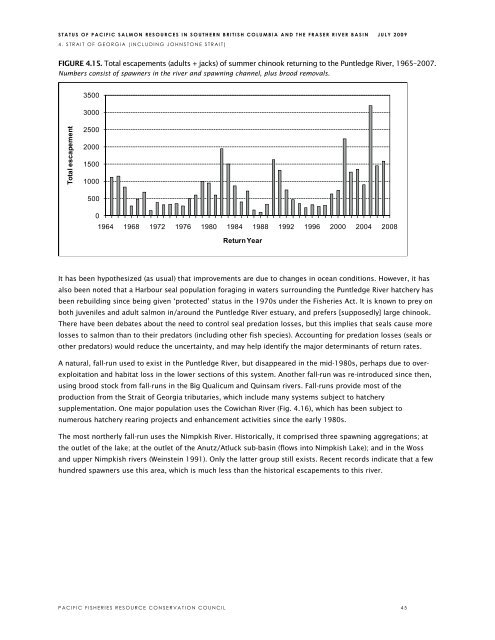Status of Pacific Salmon Resources in Southern British Columbia ...
Status of Pacific Salmon Resources in Southern British Columbia ...
Status of Pacific Salmon Resources in Southern British Columbia ...
You also want an ePaper? Increase the reach of your titles
YUMPU automatically turns print PDFs into web optimized ePapers that Google loves.
STATUS OF PACIFIC SALMON RESOURCES IN SOUTHERN BRITISH COLUMBIA AND THE FRASER RIVER BASIN JULY 20094. STRAIT OF GEORGIA (INCLUDING JOHNSTONE STRAIT)FIGURE 4.15. Total escapements (adults + jacks) <strong>of</strong> summer ch<strong>in</strong>ook return<strong>in</strong>g to the Puntledge River, 1965–2007.Numbers consist <strong>of</strong> spawners <strong>in</strong> the river and spawn<strong>in</strong>g channel, plus brood removals.35003000Total escapement250020001500100050001964 1968 1972 1976 1980 1984 1988 1992 1996 2000 2004 2008Return YearIt has been hypothesized (as usual) that improvements are due to changes <strong>in</strong> ocean conditions. However, it hasalso been noted that a Harbour seal population forag<strong>in</strong>g <strong>in</strong> waters surround<strong>in</strong>g the Puntledge River hatchery hasbeen rebuild<strong>in</strong>g s<strong>in</strong>ce be<strong>in</strong>g given ‘protected’ status <strong>in</strong> the 1970s under the Fisheries Act. It is known to prey onboth juveniles and adult salmon <strong>in</strong>/around the Puntledge River estuary, and prefers [supposedly] large ch<strong>in</strong>ook.There have been debates about the need to control seal predation losses, but this implies that seals cause morelosses to salmon than to their predators (<strong>in</strong>clud<strong>in</strong>g other fish species). Account<strong>in</strong>g for predation losses (seals orother predators) would reduce the uncerta<strong>in</strong>ty, and may help identify the major determ<strong>in</strong>ants <strong>of</strong> return rates.A natural, fall-run used to exist <strong>in</strong> the Puntledge River, but disappeared <strong>in</strong> the mid-1980s, perhaps due to overexploitationand habitat loss <strong>in</strong> the lower sections <strong>of</strong> this system. Another fall-run was re-<strong>in</strong>troduced s<strong>in</strong>ce then,us<strong>in</strong>g brood stock from fall-runs <strong>in</strong> the Big Qualicum and Qu<strong>in</strong>sam rivers. Fall-runs provide most <strong>of</strong> theproduction from the Strait <strong>of</strong> Georgia tributaries, which <strong>in</strong>clude many systems subject to hatcherysupplementation. One major population uses the Cowichan River (Fig. 4.16), which has been subject tonumerous hatchery rear<strong>in</strong>g projects and enhancement activities s<strong>in</strong>ce the early 1980s.The most northerly fall-run uses the Nimpkish River. Historically, it comprised three spawn<strong>in</strong>g aggregations; atthe outlet <strong>of</strong> the lake; at the outlet <strong>of</strong> the Anutz/Atluck sub-bas<strong>in</strong> (flows <strong>in</strong>to Nimpkish Lake); and <strong>in</strong> the Wossand upper Nimpkish rivers (We<strong>in</strong>ste<strong>in</strong> 1991). Only the latter group still exists. Recent records <strong>in</strong>dicate that a fewhundred spawners use this area, which is much less than the historical escapements to this river.PACIFIC FISHERIES RESOURCE CONSERVATION COUNCIL 45





